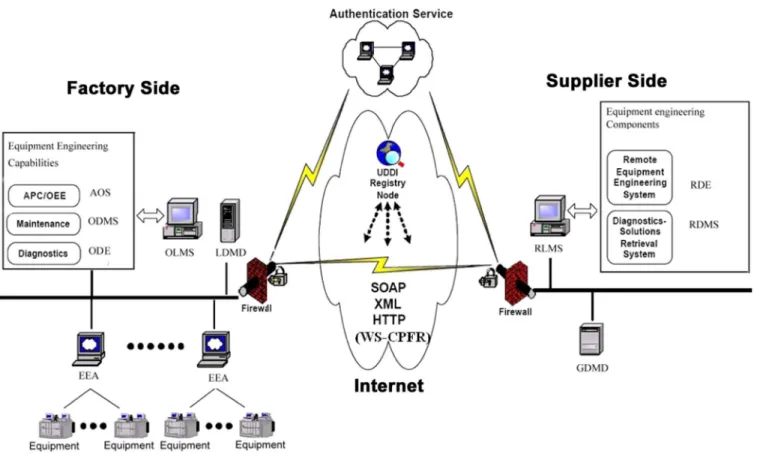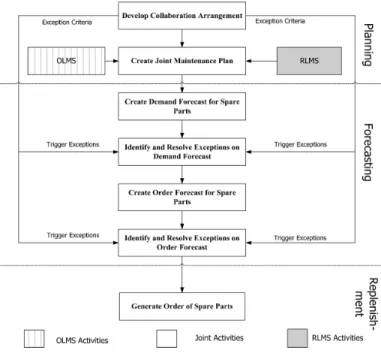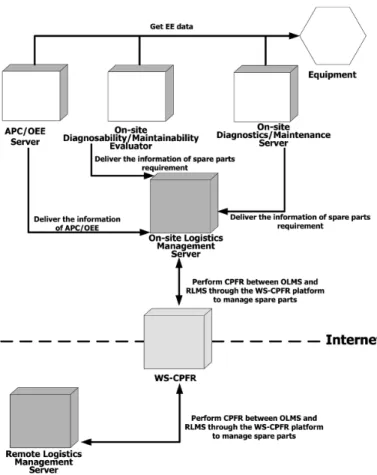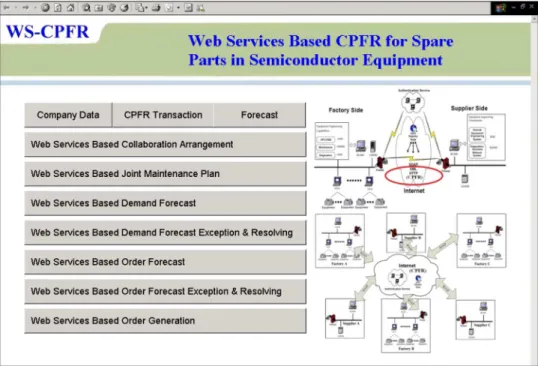596 IEEE TRANSACTIONS ON SEMICONDUCTOR MANUFACTURING, VOL. 22, NO. 4, NOVEMBER 2009
Correspondence
A Web Services-Based Collaborative Planning, Forecasting, and Replenishment (CPFR) Framework for Managing
Spare Parts of Semiconductor Equipment
Mu-Chen Chen, Kai-Ying Chen, Ming-Fu Hsu, and Cheng-Ta Yeh
Abstract—In a semiconductor foundry, equipment failure has long been
recognized as a major cause of unpredicted breakdown which results in an excessive production loss. Equipment maintenance management is one of the essential tasks in semiconductor manufacturing. Due to the pros-perity of Internet and IT, e-diagnostics and e-maintenance through the web have become important applications in the semiconductor industry. Web services (WSs) can assist the data integration in heterogeneous e-manu-facturing systems to support faster and remote maintenance functions. In this paper, a WS-based collaborative planning, forecasting and replenish-ment (CPFR) framework, namely WS-CPFR, is developed to collabora-tively manage the logistics activities of spare parts in semiconductor equip-ment between equipequip-ment suppliers and semiconductor factories.
Index Terms—Collaborative planning, forecasting and replenishment
(CPFR), e-diagnostics, e-maintenance, e-manufacturing, semiconductor industry, spare parts, web services.
NOMENCLATURE
AOS Advanced process control/overall equipment effectiveness server.
APC Advanced process control. AS Authentication service.
CPFR Collaborative planning, forecasting and replenishment. D2B Device-to-Business.
EE Equipment engineering.
EEA Equipment with embedded 1gents. EED Equipment engineering data. ERP Enterprise resource planning.
GDMD Global diagnostics/maintenance database. LDMD Local diagnostics/maintenance database.
Manuscript received June 21, 2007; revised June 22, 2009. First published July 21, 2009; current version published November 04, 2009. This work was supported in part by the National Science Council, Taiwan, R.O.C., under Grants NSC 94-2212-E-027-001 and NSC 95-2221-E-009-361-MY3. This paper was presented in part at the IEEE International Conference on Systems, Man, and Cybernetics, Taipei, Taiwan, R.O.C.
M.-C. Chen is with the Institute of Traffic and Transportation, National Chiao Tung University, Taipei, Taiwan, R.O.C. (e-mail: ittchen@mail.nctu.edu.tw).
K.-Y. Chen is with the Department of Industrial Engineering and Manage-ment, National Taipei University of Technology, Taipei, Taiwan, R.O.C. (e-mail: kychen@ntut.edu.tw).
M.-F. Hsu is with the Hon Hai Precision Industry Company, Ltd., Taipei, Taiwan, R.O.C.
C.-T. Yeh is with the Department of Industrial Management, National Taiwan University of Science and Technology, Taipei, Taiwan, R.O.C.
Color versions of one or more of the figures in this paper are available online at http://ieeexplore.ieee.org.
Digital Object Identifier 10.1109/TSM.2009.2028217
MTBF Mean time between failure. MTTR Mean time to repair.
ODME On-site diagnosability/maintainability evaluator. ODMS On-site diagnostics/maintenance server. OEE Overall equipment effectiveness.
RDME Remote diagnosability/maintainability evaluator. RDMS Remote diagnostics/maintenance server. SCM Supply chain management.
SOAP Simple object access protocol.
UDDI Universal description discovery and integration. WS Web service.
WS-CPFR Web services based collaborative planning, forecasting and replenishment.
WSDF Web services based e-diagnostics framework. WSDL Web services description language.
XML eXtensible Markup Language.
I. INTRODUCTION
In recent years, the architecture of e-manufacturing has been contin-uously emerging with the substantial advancements in Internet and IT [7]. Through these advanced technologies, e-manufacturing can seam-lessly integrate the factory shop floor system, e-diagnostics, e-mainte-nance, and e-collaboration across enterprises along the supply chain. Semiconductor manufacturers can improve the utilization and avail-ability of equipment through the effective mechanisms of diagnostics and maintenance. The intra- and inter-organizational information inte-gration and visibility allow enterprises to rapidly respond to customers’ diversified requirements as well as to reduce production costs. Web services (WSs) [12] have recently afforded an essential opportunity for inter-enterprise integration along the supply chain to realize a dy-namic virtual network in the industry [11]. In practice, however, most business applications of WSs focus on intra-organizational integration rather than inter-organizational integration. WSs can enable informa-tion integrainforma-tion among heterogeneous systems in the modern e-manu-facturing environment [5], [6].
Effective maintenance management in a foundry can substantially reduce production loss and increase facility utilization. The charac-teristics of spare parts in maintenance significantly differ from those parts in production, which result in unlike management mechanisms [4]. The service level of spare parts should be much higher since any stockouts may cause excessive production loss, particularly in semi-conductor manufacturing. Additionally, irregular demand patterns of spare parts complicate the forecasts of replenishment time and replen-ishment quantity.
Collaborative planning, forecasting and replenishment (CPFR) is a relatively new initiative proposed by Voluntary Interindustry Commerce Standards [15] to establish the collaborative mechanisms for trading partners in supply chains. For reducing uncertainty and cost, CPFR can be adopted by semiconductor manufacturers and equipment suppliers to collaboratively manage the logistics of spare parts. By integrating with the existing enterprise resource planning (ERP) and supply chain management (SCM) systems, CPFR can be
Fig. 1. Architecture of WS-CPFR.
implemented within the environment of e-manufacturing, e-diagnos-tics, and e-maintenance to provide a collaborative logistics mechanism for spare part management.
This paper aims at integrating remote equipment data collection and monitoring with the e-diagnostics/e-maintenance system in order to support an inter-enterprise framework based on WSs, which allows semiconductor manufactures and equipment suppliers to collaborate on the planning, forecasting, and replenishment of spare parts. Except for demand forecasting, the proposed WS-CPFR framework considers the diagnostics and maintenance requirements such as work order release and auditing, failure resolution, preventive maintenance, pre-dictive maintenance and corrective maintenance to replenish the spare parts. With the WS-CPFR framework, the expectation is that the mean time between failure (MTBF) will be lengthened and the mean time to repair (MTTR) shortened. Additionally, equipment engineers can effectively integrate the maintenance related tasks with logistics func-tions between semiconductor manufacturers and equipment suppliers. Semiconductor manufacturers can then significantly improve the equipment availability and utilization while decreasing the inventory levels and costs of spare parts. Equipment suppliers can also improve the service levels of spare part provisioning to semiconductor manu-facturers. The production loss stemming from equipment breakdown is expected to be significantly reduced by applying the WS-CPFR.
II. DEVELOPMENT OFWS-CPFR A. Architecture
CPFR is a recent initiative for supply chain integration and collabo-ration initiatives. Supply chain collabocollabo-ration has become a critical el-ement in the complex manufacturing environment, and CPFR applica-tions in the manufacturing field are increasing (e.g., [2]). In general, CPFR includes a planning stage, a forecasting stage, and a replenish-ment stage [15]. In these three stages, nine iterative steps are
devel-oped as the collaborative mechanism between trading partners along the supply chain. Readers are referred to [15] for the further details of CPFR.
The WS-CPFR framework is developed to collaboratively manage the logistics activities of semiconductor spare parts between equip-ment suppliers and semiconductor manufacturing firms. With the prop-erty of WS, WS-CPFR can be integrated into the WS-based e-man-ufacturing platform. To predict the demand of spare parts for semi-conductor equipment, the developed WS-CPFR framework integrates the e-diagnostics/e-maintenance functions of WS-based e-diagnostics framework (WSDF) [6] to collect equipment engineering data (EED), remotely diagnose and monitor equipment, and analyze and predict the equipment performance over the Intranet and Internet.
These equipment data and diagnostics/maintenance information col-lected by WSDF can be exchanged between semiconductor factories and equipment suppliers.
To manage the logistics of spare parts, the developed WS-CPFR is based on the functions of e-diagnostics/e-maintenance for semi-conductor equipment in WSDF. The main subsystems of WSDF [5], [6] include equipment with embedded agents (EEA), on-site diagnostics/maintenance server (ODMS) and database [local diag-nostics/maintenance database (LDMD)], advanced process control (APC) and overall equipment effectiveness (OEE) server, on-site diagnosability/maintainability evaluator (ODME) server, remote diagnostics/maintenance server (RDMS) and database [global diagnostics/maintenance database (GDMD)], and remote diagnos-ability/maintainability evaluator (RDME) server. To ensure the security of information access, WSDF incorporates an authentication service (AS) mechanism.
As WSDF, WS-CPFR can collect, integrate, and exchange data and information across networks, across platforms, and across heteroge-neous systems. In WS-CPFR, not only the diagnostics and maintenance related data, information, and systems are integrated, but the spare part
598 IEEE TRANSACTIONS ON SEMICONDUCTOR MANUFACTURING, VOL. 22, NO. 4, NOVEMBER 2009
logistics management is also integrated to support better maintenance functions and performance. Fig. 1 illustrates the architecture of the pro-posed system.
In WS-CPFR, an on-site logistics management server (OLMS) on the manufacturing factory side is developed to integrate the services in WSDF such as EEA, ODMS, LDMD, APC/OEE server (AOS), and ODME. On the equipment supplier side, a remote logistics manage-ment server (RLMS) is also developed to integrate RDMS, GDMD, and RDME. OLMS is developed according to the requirements of e-di-agnostics/e-maintenance to manage the logistics of spare parts.
In OLMS, the services components of e-diagnostics and e-mainte-nance are located at ODMS in which the diagnostics and maintee-mainte-nance data on the factory side is stored at LDMD. OLMS can access EED and DMD, respectively, from EEA and ODMS. The equipment main-tenance requirements can be forecasted by using the information of failure prediction obtained from AOS as well as the results of diagnos-ability/maintainability analysis obtained from ODME. These data can be employed to provide a more accurate forecast of required quantity and time for spare parts. OLMS is responsible for the logistics man-agement of spare parts on the factory side. RLMS is responsible for the logistics management of spare parts on the supplier side. RLMS is linked to OLMS by the WS-CPFR framework, which can allow both sides to collaborate on the planning, forecasting, and replenishment of spare parts.
With the shared information of preventive maintenance, equipment suppliers can prepare the required spare parts for manufacturing firms in advance. With the information of predictive maintenance, equipment suppliers can also more accurately predict the required spare parts for failed items. With the information of corrective maintenance, equip-ment suppliers will then be able to quickly respond with the required spare parts to the semiconductor fabs, resulting in the reduction or avoidance of production loss due to machine breakdown. The demand forecast and OEE information allow both sides to make more accu-rate replenishment decisions through CPFR. The uncertainty regarding spare parts for semiconductor equipment and replenishment lead times can be reduced by implementing CPFR, and the spare part inventory cost, equipment cost and production loss can thus be greatly decreased. B. System Development
The proposed WS-CPFR framework for semiconductor equipment has been developed according to the requirements of diagnostics and maintenance defined by WSDF as well as the CPFR guidelines defined by VICS. The service components are developed for the CPFR steps, which can support the functions and operations of OLMS and RLMS. The flowchart of WS-CPFR is illustrated in Fig. 2. In WS-CPFR, the semiconductor fab acts as the buyer and the equipment supplier acts as the seller. With respect to the requirements of e-diagnostics/e-mainte-nance, manufacturing firms share the information involving preventive maintenance, predictive maintenance, corrective maintenance, demand forecast, part degradation prediction, maintenance schedule and OEE to equipment suppliers.
In WS-CPFR, the services of spare part logistics for semiconductor equipment are discussed as follows.
Step 1) Develop collaboration arrangement for spare parts of semi-conductor equipment: Semisemi-conductor fab (buyer side) and equipment supplier (supplier side) agree on implementation principles and related guidelines to establish a collabora-tive relationship thus entering into a collaboration agree-ment for planning, forecasting and replenishagree-ment of spare parts. The collaboration agreement defines the objectives, resource requirements, shared data and confidentiality con-ditions for the WS-CPFR initiative on managing the spare parts of semiconductor equipment.
Fig. 2. Flowchart of WS-CPFR.
Step 2) Create joint maintenance plan: Both sides identify partner-ship strategies, communication and operational plan, and exception criteria for managing variation. The management profiles of other items like order commitment, lead times, and order intervals are established in this step. This step mainly identifies the spare parts for collaboration manage-ment and the shared information of maintenance policy and data. To better forecast the demand for spare parts, the WS-CPFR framework can be designed to consider three maintenance types of semiconductor equipment which are preventive maintenance, predictive maintenance and cor-rective maintenance.
Step 3) Create demand forecast for spare parts: In this step, the ac-tual spare part demands from the semiconductor manufac-turing firm are shared to generate a more accurate demand forecast. OLMS integrates the OEE data supported by AOS, ODE and ODMS to generate the schedule and prediction of preventive maintenance and predictive maintenance. With such information, WS-CPFR can generate the spare part demand forecast of spare parts. Due to the characteristics of spare parts, the demand forecast in WS-CPFR focuses both on predicting the time point and quantity of demand, whereas the original CPFR focused on predicting inventory levels only. After coordination, the generated demand fore-cast becomes the common guidance for mutual subsequent order forecasting of spare parts.
Step 4) Identify and resolve/collaborate on exceptions for demand forecast for spare parts: This step focuses on identifying the exception issues that do not satisfy the agreed criteria de-fined by both sides in the demand forecast, particularly in the time point of demand. This step also involves resolving demand forecast exceptions by querying shared data, email, telephone conversations, meetings, and so on and submit-ting any resulsubmit-ting changes to the demand forecast. Step 5) Create order forecast for spare parts: Demand forecasts of
spare parts from Step 3 is incorporated with maintenance information, equipment data and inventory policies from OLMS to support the order forecast in this step. The short-term use of the order forecast is to generate orders while the
TABLE I
FOURSCENARIOS OFWS-CPFR
long-term application exists for maintenance planning and partnership strategies of spare parts.
Step 6) Identify and resolve/collaborate on exceptions for order forecast of spare parts: Similar to Step 4, this step involves the process of identifying and investigating order forecast exceptions through querying shared data, email, telephone conversations, meetings, and so on and submitting any resulting changes to the order forecast.
Step 7) Generate order of spare parts: Once the order forecasts are agreed upon, they can be changed into committed orders. No matter which side generates orders for replenishment, the focus is on meeting the replenishment procedure. RLMS and OLMS are linked by the WS-CPFR framework, which can allow both sides to collaboratively manage the logistics activities of spare parts. The functions of service components are described above. Fig. 3 illustrates the message architecture diagram.
C. Scenarios of WS-CPFR
The involved partners of WS-CPFR may have different levels of ability and technology on managing spare parts of semiconductor equipment. The trading partners can select the appropriate WS-CPFR scenarios by considering the level of ability and technology. Four scenarios derived from the original CPFR guidelines are defined in Table I. The buyer-driven program (Scenario A) is relatively easier to implement in supply chain collaboration due to its simplicity. However, the supplier-driven program (Scenario D) is more beneficial. Therefore, semiconductor manufacturing firms and equipment sup-pliers can start the collaboration initiative of WS-CPFR from Scenario A. After the mutual trust and benefits has increased to a certain extent, Scenarios B, C or D may be further adopted.
III. WS-CPFR IMPLEMENTATION A. WS-CPFR Framework
Similar to WSDF, WS-CPFR utilizes simple object access protocol (SOAP) [8], [9] to serve as the messaging protocol which can realize the inter-operability of cross platform and distributed heterogeneous systems. Universal description discovery and integration (UDDI) per-forms the directory function to locate the WSs [10]. To exchange and integrate different kinds of information among a variety systems and platforms, eXtensible Markup Language (XML) [3], [14] is used to express the related data of diagnostics, maintenance, CPFR, and so on. Since WSs are programmable application components which can be expressed by Web Services Description Language (WSDL) [13] and published on the web, semiconductor fabs can register equipment en-gineering (EE) services on UDDI registry nodes in WSDF. Equipment suppliers also can register service components on UDDI. The client applications of WSDF can locate those EE services and diagnostics
Fig. 3. Message architecture diagram of WS-CPFR.
services on web and make use of them. WSDF also support a unified authentication-service system and a safe network connection [5], [6].
The proposed WS-CPFR is implemented by Microsoft Visual Studio.NET, and the system is operated on Windows 2000 Server. Additionally, the database management system is SQL Server 2000. The WS-CPFR framework connects OLMS in semiconductor fab to the equipment supplier. The main functions of WS-CPFR are illustrated in Fig. 4. Due to space limitations, only the main system functions are presented in this paper.
B. Global Application of WS-CPFR
Due to the transmission flexibility of WS, OLMS and RLMS can be easily incorporated with WS-CPFR and use the applications provided by WSDF. Since the transmission between OLMS and RLMS is via SOAP protocol, WS-CPFR can also be readily extended to the vision of globalization in which multiple suppliers and multiple factories can be included in the global architecture. According to the global architecture
600 IEEE TRANSACTIONS ON SEMICONDUCTOR MANUFACTURING, VOL. 22, NO. 4, NOVEMBER 2009
Fig. 4. Main functions of WS-CPFR.
of WSDF [5], [6], the global application of WS-CPFR for multifactory and multisupplier can be achieved.
IV. CONCLUSION
With respect to the requirements of spare parts of semiconductor equipment, this paper develops a WS-based CPFR framework for collaboratively planning, forecasting, and replenishing spare parts between fabs and suppliers. The developed WS-CPFR framework can make accurate decisions on replenishment of spare parts thus reducing equipment downtime, maintenance cost, and production loss. Due to the characteristics of spare parts, the demand forecast in WS-CPFR focuses on predicting both the time point and quantity of demand, whereas the original CPFR merely predicts the inventory level. The characteristics of WS-CPFR can be summarized as follows.
Spare parts are used to replace the failed parts in order to maintain the equipment availability. Due to the high demand uncertainty and extensive cost of spare parts, it is very difficult to manage the logis-tics activities of spare parts. The CPFR guidelines proposed by VICS seek to reduce the uncertainties of demand, process and supply through effective information sharing and collaboration between trading part-ners. WS-CPFR mainly integrates OLMS in the fab (factory side) and RLMS in the equipment supplier (supplier side). With the rapid ad-vancement of Internet and IT, the e-business applications have been broadened to e-diagnostics and e-maintenance for the semiconductor industry. Through these advanced technologies, semiconductor man-ufacturers can remotely collect and monitor the real-time equipment data. Therefore, they can more accurately predict the failure pattern and failure time of needed equipment. This remote data collection and monitoring mechanism can be incorporated with e-manufacturing in order to provide the inter-enterprise integration and information visi-bility of equipment status.
With WS technology, the proposed framework can easily integrate the maintenance management system and CPFR as well as synchronize with other e-business applications such as ERP, SCM, etc. In semicon-ductor manufacturing, the vision of device-to-business (D2B) can be achieved through the proposed system.
It is difficult to collaboratively resolve the exception items for sales and order forecasts in the traditional CPFR. Caridi et al. [1]
devel-oped an agent-driven negotiation process to resolve the exception items that arise in implementing CPFR. The development of an agent-based mechanism for automatic exception resolving in WS-CPFR can be an area for further investigation with future research.
REFERENCES
[1] M. Caridi, R. Cigolini, and D. De Marco, “Improving supply-chain collaboration by linking intelligent agents to CPFR,” Int. J. Production Res., vol. 43, no. 20, pp. 4191–4218, Oct. 2005.
[2] W. W. C. Chung and S. W. F. Leung, “Collaborative planning, fore-casting and replenishment: A case study in copper clad laminate in-dustry,” Production Planning Contr., vol. 16, no. 6, pp. 563–574, Sep. 2005.
[3] Guide for Style Usage of XML for Semiconductor Manufacturing Ap-plications, Jan. 2003 [Online]. Available: http://www.semi.org [4] J. Huiskonen, “Maintenance spare part logistics: Special characteristics
and strategic choices,” Int. J. Production Econom., vol. 71, no. 1–3, pp. 125–133, May 2001.
[5] M. H. Hung, K. Y. Chen, R. W. Ho, and F. T. Cheng, “Development of an e-Diagnostics/Maintenance framework for semiconductor factories with security considerations,” Advanced Eng. Informatics, vol. 17, no. 3–4, pp. 165–178, Jul.–Oct. 2003.
[6] M. H. Hung, F. T. Cheng, and S. C. Yeh, “Development of a web-ser-vices-based e-Diagnostics framework for the semiconductor manufac-turing industry,” IEEE Trans. Semiconduct. Manuf., vol. 18, no. 1, pp. 122–135, Feb. 2005.
[7] M. Koç, J. Ni, J. Lee, and P. Bandyopadhyay, “Introduction of e-man-ufacturing,” in The Industrial Information Technology Handbook, R. Zurawski, Ed. Boca Raton, FL: CRC, 2005, ch. 7, pp. 97-1–97-9. [8] Provisional Specification for XML Message Structures May 2003
[On-line]. Available: http://www.semi.org
[9] SOAP Specification Jul. 2007 [Online]. Available: http://www.w3c. org/tr/soap
[10] UDDI Specification Jul. 2007 [Online]. Available: http://www.uddi.org [11] J. van Hillegersberg, R. Boeke, and W. J. van den Heuvel, “Poten-tial of web services to enable smart business networks,” J. Information Technol., vol. 19, no. 4, pp. 281–287, Dec. 2004.
[12] W3C, 2004, Web Service Architecture Requirement Jul. 2007 [Online]. Available: http://www.w3.org/TR/ws-arch/#whatis
[13] WSDL Specification Jul. 2007 [Online]. Available: http://www.w3c. org/tr/wsdl
[14] XML Specification Jul. 2007 [Online]. Available: http://www.w3c. org/tr/xml
[15] Voluntary Interindustry Commerce Standards (VICS), Collaborative Planning Forecasting and Replenishment Voluntary Guidelines, 2002 [Online]. Available: http://www.vics.org 2002



